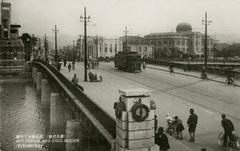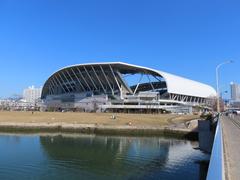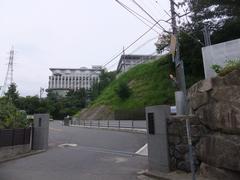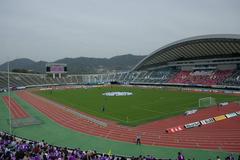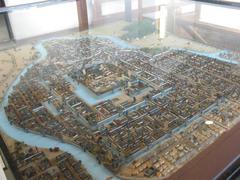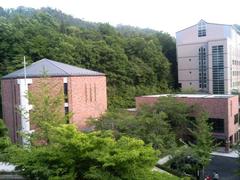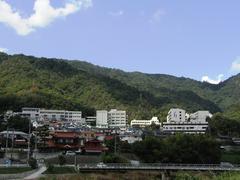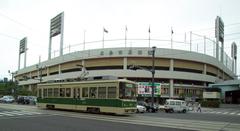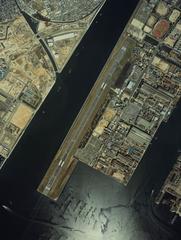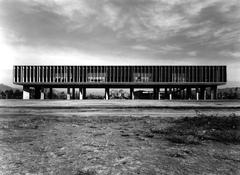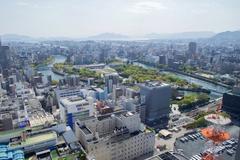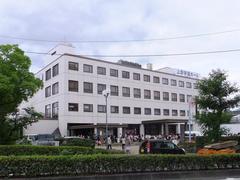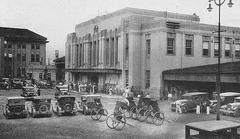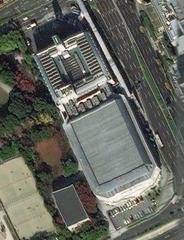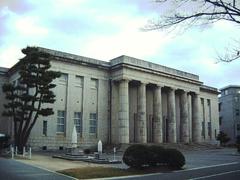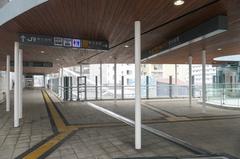Ōbara Station Hiroshima: Visiting Hours, Tickets, and Travel Guide
Date: 04/07/2025
Introduction: Ōbara Station and Its Role in Hiroshima
Ōbara Station (大原駅, Ōbara-eki) is a key junction on Hiroshima’s Astram Line, linking the dynamic Asaminami-ku area with the heart of the city. Whether you’re a daily commuter or a visitor seeking to explore Hiroshima’s storied past and vibrant present, this guide delivers essential details on Ōbara Station’s operating hours, ticketing, accessibility, and travel strategies. It also explores the station’s historical role in Hiroshima’s postwar growth and provides practical advice for making the most of your visit.
Launched in 1994 for the Asian Games, the Astram Line is a modern rubber-tired rail system designed to navigate Hiroshima’s rolling terrain. Spanning 18.4 kilometers and 22 stations, it offers smooth, quiet transit and connects travelers to major sights like Peace Memorial Park, Hiroshima Castle, and Shukkeien Garden. The nearby Ōbara Monument adds a layer of cultural depth, honoring the community’s resilience and heritage with free entry and guided tours.
Ōbara Station features barrier-free facilities, including elevators and ramps, for maximum accessibility. Tickets are easily obtained via vending machines or with PASPY IC cards, valid across Hiroshima’s public transport. Its location near local shops and eateries gives visitors a taste of daily life in Hiroshima.
This guide also highlights seasonal festivals, historic temples, lush gardens, and day-trip options such as Miyajima and Onomichi, allowing you to curate an itinerary that matches your interests. Whether you’re drawn to memorials, scenic landscapes, or energetic city life, Ōbara Station is your gateway to discovering Hiroshima’s many facets.
For live schedules and fare information, consult the Astram Line official website (https://www.astramline.co.jp/) or use real-time transit apps like Audiala. Let this guide streamline your travel and deepen your appreciation for Hiroshima’s unique blend of history and modernity (source, source, source).
Contents Overview
- Introduction to Ōbara Station and Hiroshima’s Astram Line
- Development of the Astram Line
- Route Map and Technical Details
- Ōbara Station: Visiting Hours and Ticketing
- Accessibility and Station Services
- Major Sites and Attractions Near Ōbara Station
- Astram Line’s Impact on Hiroshima’s Urban Growth
- Recent Transit Developments
- Visitor Tips for Astram Line Travel
- Frequently Asked Questions (FAQ)
- Spotlight: Ōbara Monument—Cultural Significance and Travel Info
- Exploring Hiroshima from Ōbara Station: Top Attractions
- Summary and Practical Travel Tips
Welcome to Ōbara Station and the Astram Line
Ōbara Station is an essential stop on the Astram Line, connecting Hiroshima’s expanding suburbs with the city center. This guide provides comprehensive information about the station’s hours, ticketing, accessibility, and connections to historical sites, as well as background on the Astram Line and its integration into Hiroshima’s transit system.
Development of the Astram Line
The Astram Line, or Hiroshima New Transit Line 1, was conceived in 1977 to link central Hiroshima with growing northern suburbs. Managed by Hiroshima Rapid Transit since 1987, it was designed as a rubber-tired, manually operated system to suit the city’s hilly geography. The line officially opened in August 1994, just ahead of the Asian Games, efficiently shuttling visitors between downtown and the Hiroshima Big Arch stadium.
Route Map and Technical Details
The Astram Line covers 18.4 kilometers and 22 stations, running between Hondōri (downtown) and Kōiki-kōen-mae (Big Arch stadium). Ōbara Station is strategically located along this route for convenient access. The line’s rubber-tired trains run on concrete guideways for a smooth, quiet ride. Trains are manually operated, and the line boasts an average daily ridership of about 49,300 passengers. Service operates from approximately 5:30 a.m. to midnight, with frequent departures.
Ōbara Station: Visiting Hours and Ticketing
- Operating Hours: Ōbara Station is open daily, aligned with Astram Line service from around 5:30 a.m. to midnight.
- Ticketing: Purchase tickets from vending machines at the station. Fares start at 190 yen (about $1.67 USD). The PASPY IC card offers tap-and-go convenience and is valid on Hiroshima’s buses, trams, and metro.
- IC Card Usage: PASPY is the main card, but other major IC cards, including ICOCA, are generally accepted.
Accessibility and Station Services
Ōbara Station is equipped with elevators, ramps, and clear signage, ensuring barrier-free access for passengers with mobility needs. The station’s design supports easy navigation and comfortable travel for all. Local buses stop at the station, and surrounding shops and cafes provide refreshments and glimpses into local life.
Major Sites and Attractions Near Ōbara Station
Ōbara Station’s location makes it a convenient launch point for exploring Hiroshima’s rich array of historical and cultural landmarks. Key attractions accessible via the Astram Line and transfers include:
- Peace Memorial Park & Atomic Bomb Dome: (Transfer at Hondōri Station) This UNESCO World Heritage Site is a moving tribute to the victims of the atomic bombing and a symbol of peace (source).
- Hiroshima Castle: Reconstructed after WWII, the castle offers a history museum and panoramic city views (source).
- Shukkeien Garden: A traditional landscape garden showcasing seasonal beauty, ideal for relaxation and photography (source).
- Hondori Shopping Arcade: A lively pedestrian street filled with shops, local eateries, and street performances (source).
- Hiroshima Museum of Art: Features European and Japanese art collections in a tranquil setting (source).
- Hiroshima Botanical Garden: An 18-hectare garden with diverse plant species, playgrounds, and picnic areas (source).
- Asa Zoological Park: Home to over 170 animal species and popular with families (source).
- Saijo Sakagura Street: Historic sake brewery district where visitors can sample local brews (source).
- Day Trips:
- Temples and Shrines: Notable sites include Hiroshima Gokoku Shrine, Senkoji Temple, and several others (source).
- Seasonal Festivals: Highlights include the Hiroshima Peace Memorial Ceremony (August 6), Flower Festival (May), and Sera Kogen Sunflower Festival (source).
- Local Markets and Culinary Experiences: Sample Hiroshima-style okonomiyaki, fresh oysters, and other local specialties (source).
- Parks and Green Spaces: Sakuraba Park, Hijiyama Park, and others offer recreation and city views (source).
Astram Line’s Impact on Hiroshima’s Urban Growth
The opening of the Astram Line and Ōbara Station marked a new era in Hiroshima’s redevelopment, promoting sustainable transit and supporting the city’s suburban expansion. The 1994 Asian Games expedited the line’s construction, but its enduring legacy is improved mobility, reduced congestion, and enhanced neighborhood development.
In 2015, the new Shin-Hakushima Station linked the Astram Line to JR lines, further integrating Hiroshima’s transit network. Ongoing plans for westward expansion aim to meet the city’s growing transit needs.
Visitor Tips for Using Ōbara Station and Astram Line
- Tickets: Buy single-ride tickets or use a PASPY or ICOCA IC card for seamless travel.
- Hours: Service runs from about 5:30 a.m. to midnight; check for schedule changes on holidays.
- Transfers: Key transfer points connect to JR and Hiroden lines, broadening your travel options.
- Amenities: Take advantage of local shops, eateries, and clean facilities at the station.
- Accessibility: Barrier-free design ensures comfort for travelers with mobility needs.
- Safety: The Astram Line is noted for its reliability, cleanliness, and safety standards.
Frequently Asked Questions (FAQ)
Q: What are the hours of Ōbara Station?
A: The station operates daily from approximately 5:30 a.m. to midnight.
Q: How do I buy tickets for the Astram Line?
A: Use vending machines in the station or a PASPY/ICOCA IC card for easy entry and transfers.
Q: Is Ōbara Station accessible for travelers with disabilities?
A: Yes, it features elevators, ramps, and accessible restrooms.
Q: What attractions are easily reached from Ōbara Station?
A: Peace Memorial Park, Hiroshima Castle, Shukkeien Garden, and many more are accessible via the Astram Line and connecting transit.
Spotlight: Ōbara Monument—A Hidden Gem
Overview
The Ōbara Monument (大原記念碑, Ōbara Kinenhi) is a cultural landmark commemorating local resilience and heritage. Its intricate stonework reflects early 20th-century craftsmanship and celebrates figures who shaped the region.
- Opening Hours: 8:00 a.m. – 6:00 p.m. daily
- Admission: Free
- Guided Tours: Weekends and public holidays, 10:00 a.m. – 4:00 p.m. (advance booking recommended)
- Access: 10-minute walk from Ōbara Station (JR Kabe Line), or local bus from Hiroshima Bus Center
The site is wheelchair-accessible, with paved paths and ramps. Cultural events, tea ceremonies, and art workshops are held throughout the year (hiroshima-navi.or.jp).
Visitor Tips
- Best Seasons: Spring and autumn for pleasant weather and vibrant scenery.
- Photography: Permitted except in restricted areas.
- Language: Limited English signage; translation apps advised.
- Weather: Prepare for rain in June–July.
Exploring Hiroshima from Ōbara Station: Top Attractions
Ōbara Station provides easy access to Hiroshima’s renowned sites, including Peace Memorial Park, Shukkeien Garden, Hiroshima Castle, and more. Day trips to Miyajima and Onomichi, as well as local culinary adventures and seasonal festivals, are all within reach.
Summary and Practical Travel Tips
Ōbara Station is not just a transit stop—it’s a launchpad for delving into Hiroshima’s history, culture, and natural beauty. With convenient hours, accessible facilities, and seamless ticketing, it caters to every traveler. From iconic memorials to tranquil gardens and vibrant markets, Hiroshima’s diverse attractions are effortlessly accessible from Ōbara Station.
For current schedules and travel updates, visit the Astram Line website (https://www.astramline.co.jp/) and consider using the Audiala app for real-time guidance. Plan your journey, embrace Hiroshima’s spirit of resilience, and enjoy a travel experience rich in discovery (source, source, source).
Sources and Further Reading
- Exploring Ōbara Station Visiting Hours, Tickets, and Guide to Hiroshima’s Astram Line, 2025, Hiroshima Rapid Transit (https://www.astramline.co.jp/)
- Ōbara Monument Cultural and Historical Guide, 2025, Hiroshima Tourism Board (https://hiroshima-navi.or.jp/)
- Travel + Leisure Asia: Beyond Tragedy - Explore the Resilience and Beauty of Hiroshima, 2024 (https://www.travelandleisureasia.com/sg/destinations/asia/beyond-tragedy-explore-the-resilience-and-beauty-of-hiroshima-japans-city-of-peace/)
- PlanetWare: Hiroshima Tourist Attractions, 2024 (https://www.planetware.com/tourist-attractions-/hiroshima-jpn-cg-hiro.htm)
- The Tourist Checklist: Things to Do in Hiroshima, 2024 (https://thetouristchecklist.com/things-to-do-in-hiroshima/)
Ready to explore Hiroshima from Ōbara Station? Download the Audiala app for travel updates, guided experiences, and insider tips. Follow us on social media to stay informed about events and special promotions!
